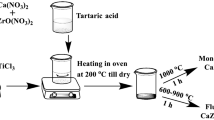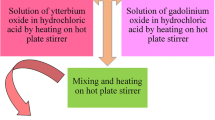A technology for synthesizing a high-purity nanocrystalline powder of zirconia doped with yttrium oxide and ceric oxide, namely ZrO2 (5% Y2O3 and 3% CeO2), is developed. The powder is characterized by high activity during sintering and the absence of hard agglomerates. The technology can be used to synthesize powders for manufacturing structural, functional, and medical purpose non-ageing ceramics.


Similar content being viewed by others
References
A. V. Shevchenko, A. K. Ruban, and E. V. Dudnik, “High-tech ceramics based on zirconium dioxide,” Ogneup. Tekhn. Keram., No. 9, 2–8 (2000).
R. A. Andrievskii and A. M. Glezer, “Size-effects in nanocrystalline materials. II. Mechanical and physical properties,” Fiz. Metal. Materialloved., 89, No. 1, 91–112 (2000).
I. P. Suzdalev and P. I. Suzdalev, “Discreteness of nanostructures and critical dimensions of nanoclusters,” Usp. Khimii, 75, No. 8, 715–752 (2006).
A. Dietrich, A. Neubrand, and Y. Hirata, “Filtration behavior of nanoparticulate ceria slurries,” J. Am. Ceram. Soc., 85, No. 11, 2719–2724 (2002).
S. Somiya and R. Roy, “Hydrothermal synthesis of fine oxide powders,” Bull. Mater. Sci., 23, No. 6, 453–460 (2000).
T. Tsukada, S. Venigalla, A. A. Morrone, and J. H. Adair, “Low-temperature hydrothermal synthesis of yttrium-doped zirconia powders,” J. Am. Ceram. Soc., 82, No. 5, 1169–1174 (1999).
B. Xia, L. Duan, and Y. Xie, “ZrO2 nanopowders prepared by low-temperature vapor-phase hydrolysis,” J. Am. Ceram. Soc., 83, No. 5, 1077–1080 (2000).
R. R. Piticescu, C. Monty, D. Taloi, et al., “Hydrothermal synthesis of zirconia nanomaterials,” J. Eur. Ceram. Soc., 21, 2057–2060 (2001).
K. Matsui and M. Ohgai, “Formation mechanism of hydrous zirconia particles produced by hydrolysis of ZrOCl2 solutions: IV. Effect of ZrOCl2 concentration and reaction temperature,” J. Am. Ceram. Soc., 85, No. 3, 545–553 (2002).
A. V. Shevchenko, E. V. Dudnik, A. K. Ruban, et al., “Hydrothermal synthesis of nanocrystall powders in the ZrO2–Y2O3–CeO2 system,” Powder Metall. Met. Ceram., 46, No. 1–2, 18–24 (2007).
A. V. Shevchenko, “Hydrothermal technologies in material science,” in: Inorganic Material Science: Fundamentals of Materials Science [in Russian], Vol. 2, Naukova Dumka, Kiev (2008), pp. 272–278.
E. V. Dudnik, “Modern methods for hydrothermal synthesis of ZrO2-based nanocrystalline powders,” Powder Metall. Met. Ceram., 48, No. 3–4, 238–248 (2009).
P. M. Kelly and L. R. Francis Rose, “The martensitic transformation in ceramics its role in transformation toughening,” Progr. Mater. Sci., 47, 463–557 (2002).
J. Chevalier, L. Gremillard, and S. Deville, “Low-temperature degradation of zirconia and implications for biomedical implants,” Annual Rev. Mater. Res., 37, 1–32 (2007).
J. Chevalier and L. Gremillard, “Ceramics for medical applications: A picture for next 20 years,” J. Eur. Ceram. Soc., 29, No. 7, 1245–1255 (2009).
H. Schubert and F. Frey, “Stability of Y-TZP during hydrothermal treatment neutron experiments and stability considerations,” J. Eur. Ceram. Soc., 25, 1597–1602 (2005).
S. V. Anisimova, L. I. Podzorova, L. I. Shvorneva, et al., “Development of zirconia-based modified dental material,” Stomatologiya, No. 5, 10–13 (2011).
G. Ya. Akimov, G. A. Marinin, and V. M. Timchenko, “Effect of tetragonal phase modifications in the surface layer on the strength of zirconia-based ceramics,” Fiz. Tverd. Tela, 47, No. 11, 1978–1980 (2005).
V. V. Lashneva, A. V. Shevchenko, and E. V. Dudnik, “Zirconia-based ceramics,” Steklo Keram., No. 4, 25–28 (2009).
A. V. Shevchenko, V. V. Tsukrenko, and E. V. Dudnik, “Ageing resistant ZrO2-based biomedical implants,” Sovr. Prom. Fiz. Materialloved., No. 21, 101–107 (2012).
E. V. Dudnik, A. V. Shevchenko, A. K. Ruban, at al., “Microstructural design of ZrO2–Y2O3–CeO2–Al2O3 materials,” Powder Metall. Met. Ceram., 49, No. 9–10, 43–54 (2010).
A. V. Shevchenko, E. V. Dudnik, A. K. Ruban, at al., “Diffusion interaction during preparation of nanocrystalline powders in the system ZrO2–Y2O3,” Powder Metall. Met. Ceram., 44, No. 3–4, 105–111 (2005).
S. Deville, J. Chevalier, and L. Gremillard, “Influence of surface finish and residual stresses on the ageing sensitivity of biomedical grade zirconia,” Biomaterials, 27, 2186–2192 (2006).
Author information
Authors and Affiliations
Corresponding author
Additional information
A. V. Shevchenko is Deceased.
Translated from Poroshkovaya Metallurgiya, Vol. 54, Nos. 9–10 (505), pp. 53–60, 2015. Original article
Rights and permissions
About this article
Cite this article
Shevchenko, A.V., Lashneva, V.V., Ruban, A.K. et al. Synthesis and Study of High-Purity Nanocrystalline Powder of a Solid Solution of CeO2 and Y2O3 in Zirconium Dioxide. Powder Metall Met Ceram 54, 548–553 (2016). https://doi.org/10.1007/s11106-016-9748-5
Received:
Published:
Issue Date:
DOI: https://doi.org/10.1007/s11106-016-9748-5




